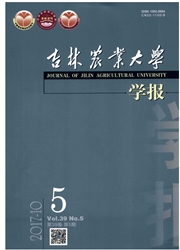

 中文摘要:
中文摘要:
白头翁菌核病是近年辽宁省白头翁种植中新发现的病害。为探究白头翁菌核病的流行成因,试验对该病原菌与7种不同来源的寄主核盘菌菌株的生物学特性及致病力进行了比较。结果表明:8株供试菌株在MEA和MEA-peptone培养基上生长最适,在MEA、OA和OA-YE上菌核形成最多;在5-25℃均可生长,其中人参菌核病菌(PSn S-R)、苍术菌核病菌(SN110812)、垂盆草菌核病菌(Ss Sn-24)、莴苣菌核病菌(Let-19)、白头翁菌核病菌(PSn F-0)菌丝生长和菌核形成的最适温度分别为20℃和15℃,大豆菌核病菌(Gm-S)、油菜菌核病菌(Bc-S)、向日葵菌核病菌(Ha-S)菌丝生长和菌核形成的最适温度为25℃;8株供试菌株在p H 4-10条件下均可生长,且菌丝生长和菌核形成的最适p H为6。致病性测定结果表明,相同条件下,接种Gm-S和Bc-S病情发生发展最快,3 d病情指数(DSI)分别为3.3和3.7,5 d病情指数最高,达6.0;刺伤接种PSn SR、SN110812、Ss Sn-24、Let-19和PSn F-0较未刺伤接种先发病,且病斑扩展更快,而刺伤接种Gm-S、Bc-S和Ha-S,与未刺伤接种差异不显著。
 英文摘要:
英文摘要:
Sclerotinia rot of Pulsatilla koreana is a new epidemic disease in Liaoning province.In order to investigate the epidemic reason of Sclerotinia rot of P.koreana,its biological characteristics and pathogenicity were compared with those of 7 Sclerotinia isolates from different hosts.The results showed that the optimum media for mycelial growth were MEA and MEA-peptone,and for sclerotial formation the optimum media were MEA,OA and OA-YE.All isolates could grow at the temperature range from 5 ℃ to 25 ℃.The optimum temperatures for mycelial growth and sclerotial formation were 20 ℃ and 15 ℃ respectively for Sclerotinia ginseng of Panax ginsen (PSnS-R),Sclerotinia nivalis of Atractylodes lancea (SN110812),S.nivalis of Sedum sarmentosum (SsSn-24),S.nivalis of Lactuca sativa (Let-19) and S.nivalis of P.koreana (PSnF-0).The optimum temperature for mycelial growth and sclerotial formation was 25 ℃ for isolates S.sclerotiorum of Glycine max (GmS),S.sclerotiorum of Brassica campestris (Bc-S) and S.sclerotiorum of Helianthus annuus (HaS).The 8 isolates could grow in pH 4- 10 and the optimum pH for mycelial growth and sclerotial formation was 6.The isolates Gm-S and Bs-C of S.sclerotiorum caused typical symptoms faster,whose DSI was 3.3 and 3.7 after 3 days.DSI was the highest on the 5th day (6.0).The isolates PSnS-R,SN110812,SsSn-24,Let-19 and PSnF-0 caused earlier and severer lesions on wounded roots than on unwounded root.There were no significant differences between wounding inoculation isolates Gm-S,Bc-S and Ha-S and unwounding inoculation isolates.
 同期刊论文项目
同期刊论文项目
 同项目期刊论文
同项目期刊论文
 期刊信息
期刊信息
